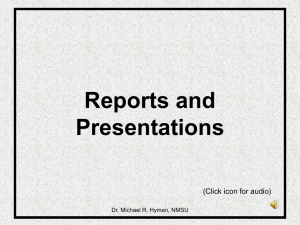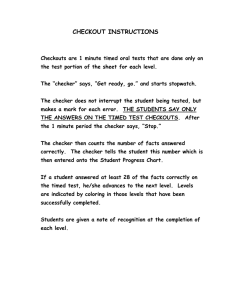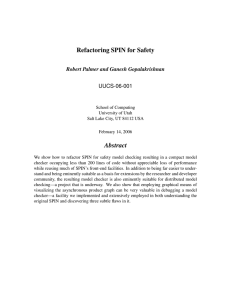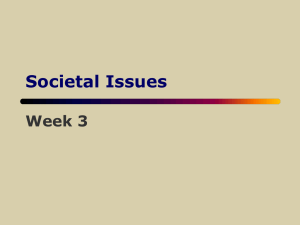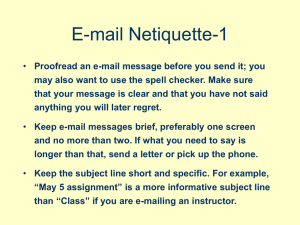Quality Management Process - Minnesota Department of
advertisement
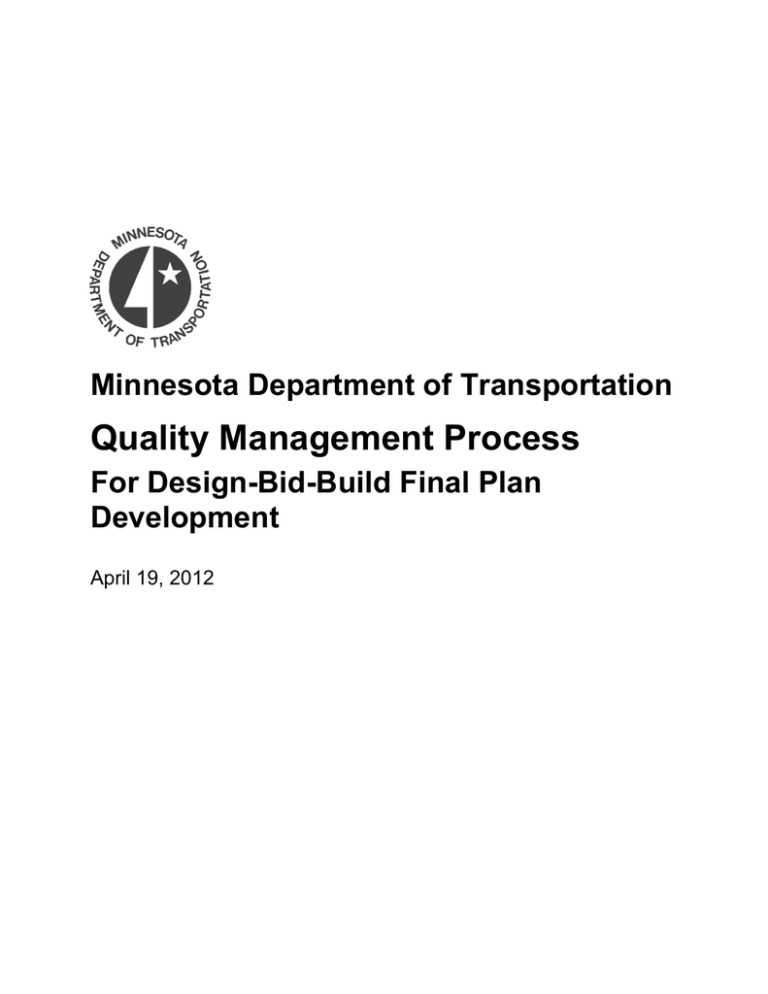
Minnesota Department of Transportation
Quality Management Process
For Design-Bid-Build Final Plan
Development
April 19, 2012
Minnesota Department of Transportation
QUALITY MANAGEMENT PROCESS
For Design-Bid-Build Final Plan Development
Table of Contents
ACKNOWLEDGEMENTS ............................................................................................... ii PURPOSE ....................................................................................................................... 1 REQUIREMENTS ........................................................................................................... 3 RESPONSIBILITIES ....................................................................................................... 5 REVIEWS ........................................................................................................................ 5 Functional Group Reviews (FGRs) and Coordination .................................................. 5 Independent Technical Reviews (ITRs) ....................................................................... 7 Independent Constructability Reviews (ICRs) ............................................................. 7 QUALITY CONTROL CHECK PROCESS ...................................................................... 9 Personnel and Duties .................................................................................................. 9 Checking Procedure .................................................................................................. 10 100% SUBMITTAL ........................................................................................................ 13 Plan and Document Submittal and Filing ................................................................... 13 Quality Assurance Verification ................................................................................... 13 APPENDIX
Quality Management Checklist
Design Decision Documentation Form
30% Complete Plan and Document Checklist
60% Complete Plan and Document Checklist
90% Complete Plan and Document Checklist
100% Complete Plan and Document Checklist
Review Transmittal Template
Review Form
Quality Control Check Process Form
Sample Checking Procedure
i
Minnesota Department of Transportation
QUALITY MANAGEMENT PROCESS
For Design-Bid-Build Final Plan Development
ACKNOWLEDGEMENTS
The following teams contributed to the development of this Quality Management
Process:
Oversight Team:
Champion – Jon Chiglo
Operations Division – Greg Ous
District Engineer – Bob Busch
Districts – Nancy Sannes (D1), Jeff Buschette (D4), Mike Kempinger (D6), and
Peter Davich (Metro)
PCMG – Todd Broadwell, Craig Collison, and John Griffith
OTS – Val Svensson, Tim Swanson, and Darwin Yasis
Technical Advisory Team:
D1 – Roberta Dwyer, Dan Erickson, Nancy Sannes (Program) and
Pat Huston (Construction)
D2 – Phillip Bergem
D3 – Todd Grater, Tom Highum, and Rick Beckes (Construction)
D4 – Jeff Buschette
D6 – Mike Kempinger and Eric Breitsprecher (Construction)
D7 – Brett Benzkofer
D8 – Paul Jurek and Kelly Brunkhorst (Construction)
Metro – Shane Rowbotham and Trudy Elsner (Maintenance)
Bridge – Angel Staples
Traffic – Bill Pirkl (D2), Mike Schweyen (D6), Mike Gerbensky (Metro), and
Mike Reynolds (Metro)
RTMC – Terry Haukom
State Aid – Ron Dahlquist
Geometrics – Darwin Yasis
Site Development – Carol Reamer
Landscape Architecture – David Larson
CAES – Lou Barrett
FHWA – Kevin Kliethermes and Brian Hogge
Consultant Team:
TKDA – Project Manager – Tim Chalupnik
TKDA – Technical Advisor – Kevin Cullen
ii
Minnesota Department of Transportation
QUALITY MANAGEMENT PROCESS
For Design-Bid-Build Final Plan Development
PURPOSE
The intent of Mn/DOT’s Quality Management Process (QMP) is to assure that a
statewide standard of quality is accomplished for the development of final plans on
design-bid-build projects. (Similar, yet distinct, processes are used on design-build
projects and on projects or portions of projects prepared by or for the Bridge Office).
The QMP is based on the philosophy that:
1.
Quality will be advocated from the top down and the bottom up.
2.
Quality is achieved by adequate planning, scoping, communications and
coordination, supervision, and technical direction; by providing adequate
time in the schedule for thorough reviews; by proper definition of job
requirements and procedures; by the use of appropriately skilled
personnel; and by individuals performing their work functions carefully.
3.
Implementing quality processes early and throughout the development of
final plans will ultimately save time and help to avoid costly errors and/or
scheduling delays.
4.
Quality is controlled through documented reviewing and checking
procedures.
5.
Quality is assured by having the Central Office Pre-Letting Section
coordinate quality assurance verification to determine whether the quality
control process and documentation were properly completed.
See the next page for a timeline of the Project Development Process from planning and
programming though construction.
1
PROJECT DEVELOPMENT PROCESS
Final Design
Preliminary Design and Environmental Studies
1
2
100% Completion
90% Completion
60% Completion
30% Completion
Begin Final Design
1
This Quality Management Process covers the Final Design phase.
Typical milestones at this stage include a Staff Approved Layout and commencement of a consultant final design contract.
2
Central Office Review
Project
Scoping
2
Planning/
Programming
Contract
Letting
and
Award
Construction
REQUIREMENTS
The QMP includes the following requirements:
1.
Mn/DOT’s senior management supports the QMP.
2.
The QMP will be reviewed and adjusted as necessary to ensure that it is
providing a benefit and that its procedures are workable.
3.
The QMP will be scalable to fit the size and complexity of each project.
The Project Manager will use the Quality Management Checklist in the
appendix to plan and schedule the project submittals and associated
checks and reviews.
4.
Design squads and functional groups will be trained in the quality
procedures.
5.
The design squad will review and check the plans and documents
throughout the course of the project.
6.
The checking process will verify that the plan set conforms with the
environmental review document, the Staff Approved Layout, and the
supporting design documentation.
7.
Significant design decisions will be documented and the documentation
will be filed in such a way that verification of the decisions can be
determined. The Design Decision Documentation form in the appendix
may be used for this purpose. If the form is not used, the information
outlined in the form should be included in the documentation.
8.
The Central Office Pre-Letting Section will coordinate quality assurance
verification.
See the next page for a flow chart of the plan and document checking and review
process outlined in this QMP. See the 30%, 60%, 90%, and 100% Complete Plan and
Document Checklists in the appendix for the requirements for each stage of completion.
3
PLAN AND DOCUMENT CHECKING AND REVIEW FLOW CHART
30% Quality Control Check Process*
Functional
Group
Reviews**
Independent
Technical
Review(s)**
Independent
Constructability
Review(s)**
60% Quality Control Check Process*
Functional
Group
Reviews**
Independent
Technical
Review(s)**
Independent
Constructability
Review(s)**
Consult with the CO
Project Delivery
Section on projects
with unique features
90% Quality Control Check Process*
Final District Review
Functional
Group
Reviews**
Independent
Technical
Review(s)**
Independent
Constructability
Review(s)**
100% Quality Control Check Process*
100% Submittal to Central Office
Quality Control
Incomplete
Central Office Quality Assurance
Verification
Quality Control Complete
Central Office Review
Resubmittals as Necessary
Project Approvals and Clearances
Advertise for Bids
*The 30%, 60%, and 90% Quality Control Check Processes may be formal or informal. The 100% Quality Control Check
Process must be formal. When using the formal process, see the Quality Control Check Process (starting on page 8) and the
Sample Checking Procedure in the appendix.
**Use the Review Form and the Transmittal Letter Template in the appendix. See the applicable sections of this manual for
more information on each review type.
4
RESPONSIBILITIES
The QMP will be followed on all projects with construction on the trunk highway system,
whether administered by Mn/DOT or a local agency.
The overall Project Manager (Mn/DOT, Consultant, or local agency staff person), or his or
her designee (hereinafter referred to as the “Project Manager”), will be responsible for
initiating the process, coordinating with all appropriate functional groups and other
agencies (FHWA, counties, cities, regulatory agencies, etc.), monitoring checking
procedures, and generally ensuring that the standard of quality established for the project
is maintained. Coordination with the functional groups includes establishing the length of
the review period, in consultation with the groups. The Project Manager will ensure that
sufficient time for reviews is allocated in the project schedule.
All pertinent questions concerning quality control will be brought to the Project Manager
for discussion and resolution. (Note: If the project is not being completed by Mn/DOT
in house staff, the Mn/DOT Project Manager will assist in coordinating with the
Mn/DOT functional groups.)
Personnel assigned to the project will be furnished with a copy of the QMP manual and
trained in its use prior to project initiation. Ongoing training will occur as required.
Prior to each scheduled review (i.e., 30%, 60%, or 90% review) functional groups will be
responsible for bringing their portion of the design to the corresponding level of
completion in time to meet the review deadline. Functional groups will also be
responsible for completing their reviews in a timely manner.
REVIEWS
Functional Group Reviews (FGRs) and Coordination
Functional Group Reviews (FGRs) provide a method for ensuring that all appropriate
functional groups and other agencies have provided input on a plan or document. FGRs
can provide a means for identifying conflicts and determining compatibility between
disciplines. Plans and documents that will be submitted for an FGR include those that
involve more than one discipline or that may impact another discipline.
FGRs can be the formal process outlined below or informal discussions, initiated by a
squad leader or the Project Manager, as the need arises. Regardless of what method is
used (and more than one method may be used on a project), any significant decisions
resulting from the FGR will be documented in such a way that, as necessary,
verification of the decisions can be determined.
The Project Manager will identify all plans and documents that will require a formal FGR
and determine the need for or benefit from conducting this review simultaneously with
either or both the Independent Technical Review and the Constructability Review.
5
Note: Formal FGRs are not the same as the Quality Check Process outlined
elsewhere in this QMP, and they do not require review of the entire plan set by
each functional group.
For each plan or document to be reviewed, the Project Manager will coordinate reviews
from the following District and Central Office functional groups, as appropriate:
District Functional Groups*
Construction
Design (Preliminary and Final)
Hydraulics/Water Resources
Maintenance
Materials (District)
Permits
Right-of-Way
RTMC (Regional Traffic Management
Center)
State Aid
Surveys
Traffic (Lighting, Signing, etc.) (District)
Central Office Functional Groups*
ADA Compliance
Bike and Pedestrian
Bridge
Design Support
Environmental Services
Foundations
Geometrics
Land Management
Landscape Unit
Materials
Municipal Agreements
Railroad
Site Development
Special Provisions
Traffic (Lighting, Signing, etc.)
Transit
Utility Agreements and Permits
*These lists are not all-inclusive. Project Managers may wish to have reviews by other groups.
The Project Manager will assemble the review package (including the Review Form and
the Transmittal Letter, included in the appendix) and provide copies of the package to
the FGR Reviewers.
The selected FGR Reviewers will be responsible for assuring the compatibility of the
deliverable with the reviewer’s discipline. Information found to be incorrect will be lined
through and corrected in red, and comments or instructions will also be written in red.
Upon completion of the review, each FGR Reviewer will provide the completed Review
Form (including sign-off by the Functional Group lead) and the red-lined review package
(if comments are noted on the package and not on the review form) to the Project
Manager.
The design squad will review the comments and respond on the Review Form under
“Response by Design Squad.” Usual phrases are “Will comply” and “Further discussion
needed.”
The Project Manager may convene a meeting of the reviewers if he/she determines that
such a meeting would be beneficial to resolve comments or conflicts. Some projects
have project management team meetings that serve this function.
6
After the needed discussion has occurred, the design squad will update the responses
as necessary. When the Functional Group Lead concurs with all of the actions taken,
he/she will sign-off on the Review Form.
Independent Technical Reviews (ITRs)
Independent Technical Reviews (ITRs) are an opportunity to obtain input from an
independent expert who is not otherwise involved in the project and can therefore bring
a fresh set of eyes to the review of a plan or document. ITRs can occur at any time in
the plan development process. ITRs are intended for specific project elements of a
complex or unique nature.
The Project Manager will identify all plans and documents that will require an ITR and
determine the need for or benefit from conducting this review simultaneously with either
or both the Functional Group Review and the Constructability Review. The Project
Manager may contact other Districts and/or Functional Group Leads for identifying
resources for ITRs.
For each plan or document to be reviewed, the Project Manager will select the ITR
Reviewer, assemble the review package (including the Review Form and the
Transmittal Letter, included in the appendix) and provide the package to the ITR
Reviewer.
The ITR Reviewer will review the plan or document for intent, technical adequacy, and
conformance to any applicable standards and format with regard to those aspects of the
design he/she has reviewed.
The reviewing activity will be recorded directly on the review package. Information found
to be incorrect will be lined through and corrected in red, and comments or instructions
will also be written in red.
Upon completion of the review, the ITR Reviewer will provide the completed Review
Form and the red-lined review package (if comments are noted on the package and not
on the review form) to the Project Manager.
The design squad will review the comments and respond on the Review Form under
“Response by Design Squad.” Usual phrases are “Will comply” and “Further discussion
needed.” The Project Manager will collect and resolve comments resulting from the ITR
and make sure the comments are addressed.
Independent Constructability Reviews (ICRs)
Independent Constructability Reviews (ICRs) are conducted to obtain input so that
construction-related expertise is incorporated into complex or unique designs. This may
include reviews by Mn/DOT staff or by a contractor or consultant. (Note: If a contractor
or consultant is considered to provide input, care must be given to ensure that a
prospective bidder is not given an unfair advantage. Coordination with the Offices of
Construction and Innovative Contracting must also occur.)
7
The Project Manager will identify plans that will require an ICR and determine the need
for or benefit from conducting this review simultaneously with either or both the
Functional Group Review and the Independent Technical Review.
For each plan to be reviewed, the Project Manager will assemble the review package
(including the Review Form and the Transmittal Letter, included in the appendix) and
provide the package to the ICR Reviewer(s).
The ICR Reviewer(s) will review the plan to ensure that it reflects design or procedures
that do not unnecessarily impede construction activities and that reflect any simplifications
or savings associated with construction methods of which the designer may not be aware.
The following are some of the project elements the ICR Reviewer(s) may focus on:
•
•
•
•
•
•
•
•
•
•
•
•
•
•
•
General completeness and clarity of information
Achievability of specified tolerances
Existence of adequate site access for work proposed
Restrictions to site access have been addressed
Environmental constraints have been addressed
Utility conflicts have been addressed
Availability of materials
Storage area for required materials is available, if necessary
Design is prudent, economical, and consistent with design objectives
Any other items that reflect construction perspective and improve deliverable
Scheduling
Staging
Maintenance of traffic
Contract time
Business or community impacts
Information found to be incorrect will be lined through and corrected in red, and
comments or instructions will also be written in red.
Upon completion of the review, the ICR Reviewer(s) will provide the completed Review
Form and the red-lined review package (if comments are noted on the package and not
on the review form) to the Project Manager.
The design squad will review the comments and respond on the Review Form under
“Response by Design Squad.” Usual phrases are “Will comply” and “Further discussion
needed.” The Project Manager will collect and resolve comments resulting from the ICR
and make sure the comments are addressed.
8
QUALITY CONTROL CHECK PROCESS
The primary goals of this process are to provide a technical review of project plans and
documents by a qualified staff member, to allow the designer or author/collator of the
plan or document and the reviewer to come to a consensus on any changes, and to
make certain any needed changes are made correctly.
The Quality Control Check Process may be the formal process described below or an
informal process determined by the Project Manager. The formal process must be used
at 100% completion (prior to submittal to the Central Office) and may be used at the
30%, 60%, and 90% stages of completion. It is recommended that the formal process
be used more often on complex projects.
Documentation of formal and informal checking processes shall be kept in the project
file until the Contract is awarded.
The core of the formal Quality Control Check Process involves checking, correcting, and
verifying that the corrections have been made. Back checking, as outlined below, is not
required until the check at 100%.
The following plans and documents will be subject to this checking process:
•
•
•
•
•
•
Construction plans
Special provisions
Design and quantity calculations
A design document (for example, design exceptions, design memos,
Public Interest Findings)
A cost estimate
A schedule
Personnel and Duties
Originator: The Originator will usually be the designer or author/collator of the plan or
document. The Originator will have the primary responsibility for accuracy and
adequacy. In most cases, the Originator will also function as the Back Checker.
Checker: The Checker will be responsible for checking the plan or document
independently of the Originator (the Checker must not have prepared the item being
checked). In most cases, the Checker will also function as the Verifier.
For plans, calculations, specifications, special provisions, and design documents,
the Checker will be a qualified person with sufficient knowledge and experience
in the discipline of the work being checked.
9
For structural design plans and calculations, the Checker will be a licensed
Professional Engineer, as appropriate, with sufficient knowledge and experience
to understand the analysis and design components of the project; the use of
standards; and the requirements, constraints, and limitations of incorporating the
standards in the project.
For computer program input, the Checker will be skilled in the use of the design
software being used.
Back Checker: The Back Checker (usually the Originator) will be responsible for
confirming/denying corrections asserted by the Checker. In cases where no corrections,
additions, or deletions were found, there will be no need for back checking. Back
checking may be used but is not required until the check at 100%.
Corrector: Correction of the plan or document will be completed by the Corrector, who
may be the Originator, or a CADD technician, administrative assistant, or other
personnel (as appropriate).
Verifier: The Verifier (usually the Checker) will be responsible for confirming that
corrections have been accurately made.
Central Office: The Central Office Pre-Letting Section will coordinate the Quality
Assurance verification.
Checking Procedure
See the Sample Checking Procedure in the appendix for an example of the mark-ups
outlined in the following procedure.
1.
The Originator will prepare the Check Print. See page 9 for a list of plans and
documents that could constitute a “Check Print.”
On the Check Print, the Originator will make sure that all plan sheets are
appropriately numbered or that the pages of all other documents, including
calculations, are sequentially numbered.
The Originator will fill out the top of the Quality Control Check Process Form
(included in the appendix). The form will be attached to the Check Print. The
Originator will sign and date the Quality Control Check Process Form and
provide the Check Print to the Checker.
10
2.
The Checker will check the plan or document and record the checking activity on
the Check Print.
Information found to be correct will be highlighted in yellow. * The checker may
choose to use yellow marks or yellow checkmarks rather than highlighting the
information. No matter what type of marking style is used, the markings must
clearly show that the checking occurred.
Information found to be incorrect will be lined through and corrected in red, and
comments or instructions will also be written in red.
For calculations, the Checker will thoroughly check the calculations including
assumptions, mandated parameters, references, given values, and formulas;
check for omissions and accuracy of arithmetic; ask questions of the designer in
areas that are not clear or where additional calculations are required; seek
technical advice if unsure of any particular element of the calculation; and review
the output data of computer calculations for consistency with expected results.
For computer program input and output, the Checker will thoroughly check the
input parameters and all assumptions, references, and mandated values. In the
case of GEOPAK output, the Checker will thoroughly check the output and
associated reports, as well as measure or visually verify the CADD files to ensure
that desirable results have been attained and that design standards or required
criteria have been met. In the case of non-GEOPAK related output, the Checker
will thoroughly check graphical output by measuring or visually verifying to
ensure that the desired results have been achieved.
For plans, the Checker will use the appropriate plan review checklists. The
following is a list of checklists that could be utilized:
Road Design Plans Final Checklist (Design Scene, Chapter 18)
http://www.dot.state.mn.us/pre-letting/scene/download/
scene-complete.pdf#chapter-18
30%, 60%, and 90% Plan Review Checklists (Metro District Final Design)
http://www.dot.state.mn.us/metro/finaldesign/docs.html
Traffic Signal Design Checklists (Signal Design Manual)
http://www.dot.state.mn.us/trafficeng/publ/signaldesign/
2010%20Signal%20Design%20Manual/2010_Signal_Design_Manual.pdf
The Checker will check the entire drawing for design intent, technical adequacy,
and conformance to any applicable standards and format. The Checker will be
responsible for determining that the drawing is consistent with the corresponding
calculations and for affirming that those calculations have been properly
*
The colors specified in this Quality Control Check Process are recommended; however, Districts can
choose their own colors, provided that the various steps in the checking process can be distinguished on
the Check Print.
11
checked. The Checker will also check to ensure that all relevant design
documents have been incorporated.
For specifications and special provisions, the Checker will review the document
for applicability and clarity. The Checker will review the entire document, even if
only a small portion has changed, to ensure that revisions have not introduced
conflict or ambiguities. The Checker will also review the special provisions
together with the plans to ensure that all necessary pay items have been
covered, that the pay item units are correct, and that the plans and special
provisions are consistent. The Checker will also check to ensure that all relevant
design documents have been incorporated.
For design documents, each Checker will place their initials next to their
comments or corrections (this is not necessary if using Track Changes in Word,
which automatically records this information). Checkers will review the document
with regard to their responsible area, conformance with project criteria and
requirements, and content. They will also review those parts of the document that
interface with their area of responsibility to assure that there are no conflicts. The
editorial reviewer will be responsible for assuring uniform format, proper
sentence structure, proper syntax, and spelling.
Note: For checking related to non-standard structures, refer to the Bridge
Office Quality Manual. Non-standard structures include those with any
deviation from the Standard Plans.
Following the checking, the Checker(s) will sign and date the Quality Control
Check Process Form and provide the Check Print and the form to the Back
Checker.
3.
The Back Checker will review each of the Checker’s corrections (red marks) and
will record the back-checking activity on the Check Print.
If the Back Checker is in agreement with a correction, the Back Checker will
place a check mark in green next to the correction.
If the Back Checker finds any additional changes not picked up by the Checker,
the Back Checker will confer with the Checker and, with the concurrence of the
Checker, will add the additional changes in green.
If the Back Checker is not in agreement with a Checker’s correction, the Back
Checker will confer with the Checker. If both agree that the Checker’s correction
should not be made, the Back Checker will cross out the Checker’s correction in
green. The Back Checker must not obliterate the Checker’s marks. If the Back
Checker and Checker cannot achieve resolution, the Project Manager will be
consulted to resolve the differences.
Following the back checking, the Back Checker will sign and date the Quality
Control Check Process Form and provide the Check Print and the form to the
Corrector.
12
4.
The Corrector will make the changes to the plan or document and will highlight
or circle in blue each correction as incorporated.
When all of the corrections have been made, the Corrector will sign and date the
Quality Control Check Process Form. A new copy of the corrected plan or
document and the marked-up Check Print will be provided to the Verifier.
5.
The Verifier will compare the new copy of the plan or document with the Check
Print to confirm that the agreed-to corrections have been incorporated without
error.
If a correction has been properly made on the new copy, the Verifier will crosshighlight in yellow the blue circle or highlight on the Check Print.
If a correction has not been made or is in error, the new copy of the plan or
document will be annotated in red and returned to the Corrector. The Corrector
will make the corrections as outlined above and provide a new copy of the plan
or document to the Verifier.
Once all corrections have been properly made and verified, the Verifier will sign
and date the Quality Control Check Process Form.
100% SUBMITTAL
Plan and Document Submittal and Filing
When all project plans and documents have been checked, the Project Manager will file
the Quality Control Check Process Form for each item in ProjectWise and submit the
plans, special provisions, and cost estimate to the Central Office. (If desired, the District
may perform quality assurance verification prior to submittal to the Central Office.)
The Check Print for each item (hard or electronic copy) shall be kept by the Project
Manager until the construction contract is awarded.
Quality Assurance Verification
The Central Office Project Delivery Section will review the Quality Control Check
Process Forms to determine whether or not the quality control procedures described in
steps 1-5, above, were implemented. In certain circumstances, the Central Office
reviewer may also review the Check Prints at the Project Manager’s office.
The reviewer will coordinate with the Project Manager (or others as appropriate) to
resolve all issues arising from the quality assurance verification.
Once the verification is complete and any nonconformance issues have been resolved,
the reviewer will sign and date the Quality Control Check Process Form. The completed
form will be filed in ProjectWise.
13
APPENDIX
QUALITY MANAGEMENT CHECKLIST
(To be completed by the Project Manager at the beginning of Final Design
and updated throughout the project)
Project Manager:
Design Squad:
State Project No.:
Project Description:
Programmed Letting Date:
Checking* and Reviews at:
30% Complete:
Planned
Date**
Completed
Date**
Not
Needed
(A detailed explanation is required if Not Needed is
checked.***)
Indicate which reviews are planned below.
Needed
Not Needed
(A detailed explanation is required if Not Needed is checked.***)
FGR
ITR
ICR
60% Complete:
Planned
Date**
Completed
Date**
Not
Needed
(A detailed explanation is required if Not Needed is
checked.***)
Indicate which reviews are planned below.
Needed
Not Needed
(A detailed explanation is required if Not Needed is checked.***)
FGR
ITR
ICR
90% Complete:
Planned
Date**
Completed
Date**
Indicate which reviews are planned below.
Needed
Not Needed
(A detailed explanation is required if Not Needed is checked.***)
FGR
ITR
ICR
100% Complete:
Planned
Date**
Completed
Date**
* Formal or informal at 30%, 60%, and 90%. Formal at 100%.
** The date plans and documents are completed, checked, and ready for review.
*** N/A or equivalent is not acceptable.
4/19/12
DESIGN DECISION DOCUMENTATION FORM
Project Manager:
Design Squad:
State Project No.:
Project Description:
Re:
Date:
Decision Makers:
Summary of Decision (what/why):
5/18/11
30% COMPLETE PLAN AND DOCUMENT CHECKLIST
(To be completed by the Design Squad)
Project Manager:
Design Squad:
State Project No.:
Project Description:
Completed*
(date)
1.
Preliminary design surveys
2.
Title sheet
3.
Typical roadway sections
4.
Staging concept
5.
Plan and profile sheets with calculated
horizontal and vertical alignments
6.
Intersection and interchange layouts
7.
Consideration of pedestrian facilities and ADA
compliance features
8.
Initial drainage plan with major features
9.
Initial R/W requirements/construction limits
10.
Initial utility conflicts determined
11.
Cross sections with top surface
12.
Staff Approved Layout
13.
Bridge structure selection reports
14.
Preliminary bridge plans
15.
Traffic analysis and report
16.
Capacity analysis and level of service analysis
17.
Preliminary geotechnical report
18.
Prel. Materials Design Recommendation report
19.
Cost estimate
20.
Preliminary assessment of business impacts
21.
Value engineering study
22.
Visual quality features
23.
Determination of funding sources
Not
Needed
24.
25.
* Provide an explanation if any item is not completed. Attach an additional sheet if needed.
4/19/12
60% COMPLETE PLAN AND DOCUMENT CHECKLIST
(To be completed by the Design Squad)
Project Manager:
Design Squad:
State Project No.:
Project Description:
Completed*
(date)
1.
2.
3.
4.
5.
6.
7.
8.
9.
10.
11.
12.
13.
14.
15.
16.
17.
18.
19.
20.
21.
22.
23.
24.
25.
26.
27.
28.
29.
30.
Not
Needed
Title sheet
General layout
Begin Estimated Quantities sheet
Soils and construction notes
Typical roadway sections
Staging/traffic control (including bike/peds/transit)
Plan and profile sheets
Drainage plans and preliminary report (drainage
and area map and comps)
Intersection details
ADA compliance features
Special structures – coordination with Bridge Office
Landscape plans
Signing and pavement marking plans
Lighting, signal, RTMC plans
Final R/W plans and descriptions
Final known utility impacts
Public utility relocation design and plans
Major private utility plans
Temporary and permanent erosion control plans
Cross sections
Draft special provisions index
Cost estimate
Final Materials Design Recommendation report
Permits identified and applications started
SWPPP
Business impacts assessment
Visual quality features
Agreement information
* Provide an explanation if any item is not completed. Attach an additional sheet if needed.
Note: Items not referenced as draft or final will generally be 60% complete.
4/19/12
90% COMPLETE PLAN AND DOCUMENT CHECKLIST
(To be completed by the Design Squad)
Project Manager:
Design Squad:
State Project No.:
Project Description:
Completed
(date)
1.
Full plan set
2.
Draft special provisions
3.
Agreements
4.
Public Interest Finding (PIF)
5.
Permit applications in process or permits received
6.
Utility permits
7.
R/W certificates
8.
Cost estimate
9.
Design calculations (roadway, drainage, etc.)
10.
11.
4/19/12
Not
Needed
100% COMPLETE PLAN AND DOCUMENT CHECKLIST
(To be completed by the Design Squad)
Project Manager:
Design Squad:
State Project No.:
Project Description:
Completed
(date)
1.
Submittal letter
2.
Certified originals
3.
Final special provisions
4.
Final designer construction cost estimate
5.
Environmental permits
6.
7.
5/18/11
Not
Needed
STATE OF MINNESOTA
DEPARTMENT OF TRANSPORTATION
Office Memorandum
DATE:
__________
TO:
Addressees
FROM:
__________
SUBJECT:
SP __________
Funding: __________
FGR/ITR/ICR Review
Attached for your review and comment are __________ for the above referenced
project.
The letting date for this project is __________. The construction starting date will be
__________. There will be __________ working days allowed. Intermediate Completion
of Project (Open to Traffic) will be __________. Project completion will be __________.
The Programmed estimate is $__________. The current District construction cost
estimate is $__________. The total project cost estimate is $__________.
Please use the attached Review Form for your comments. Make your comments clear
and self-explanatory. Attach examples if they will make your comments clearer. Make
additional copies of the form if required. If you have questions, please call me to discuss
them.
The _________ is a critical element of the project, so comments relating to _________
would be appreciated.
Please return the Review Form (even if you have no comments) and your
comments to me no later than _________. This is the final date for comments.
The following letters after your functional group represent the portions of the plan
package you are receiving: (P) = plan, (X) = cross sections, (S) = special provisions.
Addressees:
Construction, ___
Design (Preliminary and Final), ___
Hydraulics/Water Resources, ___
Maintenance, ___
Materials (District), ___
Permits, ___
Right-of-Way, ___
RTMC (Regional Traffic Mgmt. Ctr.), ___
State Aid, ___
Surveys, ___
Traffic (Lighting, Signing, etc.), ___
__________, ___
REVIEW FORM
Due Date:
Date Sent:
Project Manager:
State Project No.:
Design Squad:
Project Description:
Review Phase:
30%
60%
90%
(specify)
Review Type:
FGR (Functional Group Review)
ITR (Independent Technical
Review)
ICR (Independent Constructability
Review)
(project element)
Functional Groups:
ADA Compliance
Construction
Design (Preliminary and Final)
Hydraulics/Water Resources
Maintenance
Materials (District)
Permits
Right-of-Way
RTMC (Regional Traffic Mgmt. Ctr.)
State Aid
Surveys
Traffic (Lighting, Signing, etc.)
Comments By:
Name:
Phone:
Date:
*Functional Group Lead Concurs With Comments (below):
Name:
Signature:
Date:
*Functional Group Lead Concurs With Design Response (below):
Name:
* For FGRs only.
Comment
Sheet or
No.
Page No.
4/19/12
Signature:
Comment (provide detailed comment or refer to redlined review package)
Date:
Design Response
Page ___ of ___
REVIEW FORM
Due Date:
Date Sent:
Project Manager:
State Project No.:
Design Squad:
Project Description:
Comment
No.
4/19/12
Sheet or
Page No.
Comment (provide detailed comment or refer to redlined review package)
Design Response
Page ___ of ___
QUALITY CONTROL CHECK PROCESS FORM
Project Manager:
Design Squad:
State Project No.:
Project Description:
Item to be Checked:
Originated by:
Print name
Sign
Date
Print name
Sign
Date
Print name
Sign
Date
Print name
Sign
Date
Print name
Sign
Date
Checked by:
Back Checked by:
Corrected by:
Verified by:
Quality Assurance Verification by Central Office Project Delivery Section:
Print name
4/19/12
Sign
Date
SAMPLE CHECKING PROCEDURE
CHECK PRINT
.
R
’
0
4
{ MAIN ST.
BEGIN TAPER
1
5
:
1
14’
ORIGINATOR
END TAPER
STA. 14+85
STA. 15+45
8’
15
12’
12’
12’
12’
10’
10’
B624 C&G
CHECK PRINT
.
R
’
0
4
{ MAIN ST.
BEGIN TAPER
STA. 14+85
1
:
1
5
1
5
:
1
CHECKER
END TAPER
STA. 15+45
8’ 10’
YELLOW
14’
4
0
’
R
12’
12’
12’
12’
10’
RED
CORRECTIONS, COMMENTS, AND
INSTRUCTIONS
10’
SHOW AND LABEL
CONSTRUCTION LIMITS
.
CORRECT INFORMATION HIGHLIGHTED
AS NECESSARY TO VERIFY THAT
ALL ELEMENTS HAVE BEEN CHECKED
15
B624 C&G
B424
CHECK PRINT
.
R
’
0
4
{ MAIN ST.
BEGIN TAPER
STA. 14+85
1
:
1
5
1
5
:
1
14’
4
0
’
R
BACKCHECKER
END TAPER
STA. 15+45
8’ 10’
REQUIRED ONLY AT 100%
12’
12’
12’
12’
10’
GREEN
10’
SHOW AND LABEL
CONSTRUCTION LIMITS
.
(Usually the Originator)
15
CHECK MARK IF IN AGREEMENT
WITH CORRECTION
SEE EXAMPLE TO THE LEFT IF NOT
IN AGREEMENT WITH CORRECTION
B624 C&G
B424
BACKCHECKER AND CHECKER
DISCUSS AND RESOLVE DIFFERENCE.
DECISION IS MARKED BY BOTH.
CHECK PRINT
.
R
’
0
4
{ MAIN ST.
BEGIN TAPER
STA. 14+85
1
:
1
5
1
5
:
1
CORRECTOR
END TAPER
STA. 15+45
8’ 10’
BLUE
14’
4
0
’
R
15
12’
12’
12’
12’
10’
10’
SHOW AND LABEL
CONSTRUCTION LIMITS
.
CIRCLE OR HIGHLIGHT CORRECTIONS
MADE
B624 C&G
B424
CHECK PRINT
.
R
’
0
4
{ MAIN ST.
BEGIN TAPER
STA. 14+85
1
:
1
5
1
5
:
1
14’
4
0
’R
VERIFIER
END TAPER
STA. 15+45
8’ 10’
15
12’
12’
12’
12’
10’
10’
SHOW AND LABEL
CONSTRUCTION LIMITS
.
B624 C&G
B424
CORRECTED PLAN SHEET
CONSTRUCTION
.
R
’
0
4
LIMITS
{ MAIN ST.
BEGIN TAPER
END TAPER
STA. 14+85
1
:
1
5
14’
(Usually the Checker)
STA. 15+45
10’
15
12’
12’
12’
12’
10’
10’
B624 C&G
.
R
’
0
4
CONSTRUCTION
LIMITS
YELLOW
CROSS HIGHLIGHT CORRECTIONS
PROPERLY MADE
